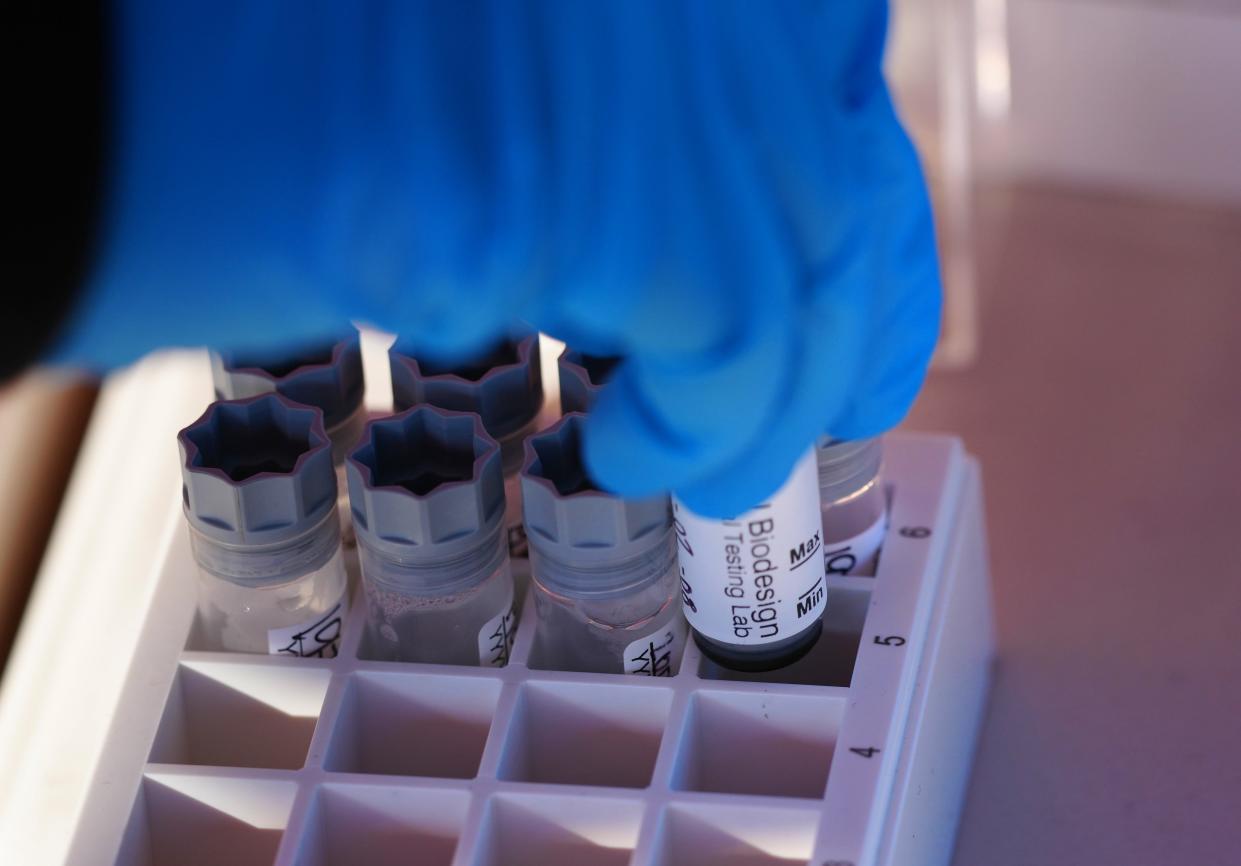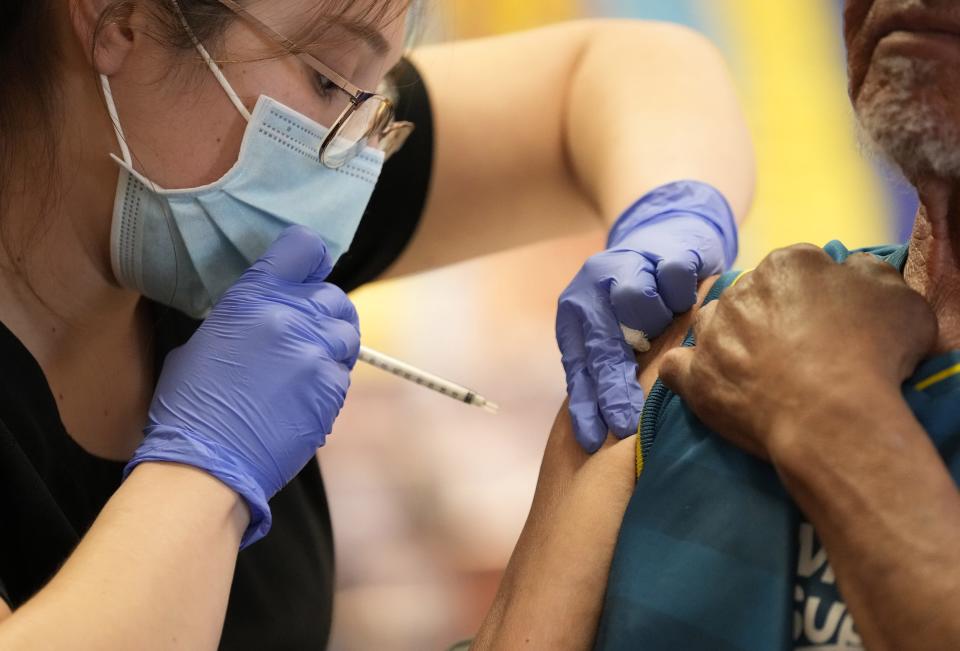COVID-19 update: Ariz. case numbers rise to 'high,' masks recommended in 14 of 15 counties

Reported COVID-19 cases in Arizona last week increased from weeks prior, and the portion of tests returning positive for the virus was at one in four after the Thanksgiving holiday, according to the state's latest weekly update.
Health officials on Wednesday added 15,983 new COVID-19 cases and 71 new known deaths over the weeklong period ending Dec. 3, the highest weekly case addition since late July.
Fourteen of Arizona's 15 counties, including Maricopa, were designated as “high” in terms of COVID-19 levels as of Dec. 8, according to guidance from the Centers for Disease Control and Prevention, meaning the CDC recommends people wear face masks indoors in public. Mohave County was the only one designated as "medium."
The CDC’s “community level” guidance metrics are based on a county’s COVID-19 hospital bed use, COVID-19 hospital admissions and case rates for the virus over the past week.
Case counts are still far below last winter, state data shows. Case numbers in recent months likely are not showing the full picture of infections as many more people have used at-home test kits and may not report positive results to their doctors or county health departments.
Some epidemiologists had predicted another wave of infections this fall and winter. Omicron subvariants that have fueled a rising number of COVID-19 cases in Europe and western Asia are present in Arizona, setting the stage for another bump in cases here.
Public health officials and medical providers say the best way for Arizonans to avoid serious illness from the emerging strains is to get the updated COVID-19 booster if eligible. The new bivalent booster is updated with protections against subvariants of the omicron variant, and it's available to people ages 5 and older.
Reported cases since the pandemic began are at over 2.3 million. Known deaths in Arizona are over 31,800.
Wednesday marked the 41st of the weekly updates to the state's data dashboard, instead of daily updates that Arizonans had become accustomed to following for the latest data on infections, illnesses and deaths.
The previous week's update added 12,987 cases and 42 deaths, compared with 13,410 cases and 62 deaths three weeks ago and 10,775 COVID-19 cases and 34 deaths four weeks ago.
This week's update shows the differences between data reported for the week of Nov. 27-Dec. 3 and Nov. 20-26.
Health officials say weekly updates match how public health monitors trends and other disease reporting.
Case numbers generally were relatively lower in the past couple of months, and public health experts estimate cases of the highly contagious omicron variant peaked in Arizona around mid-January 2022.
The state data dashboard no longer shows key hospitalization information since Gov. Doug Ducey ended the COVID-19 emergency declaration March 30. State health officials said hospitals are no longer required to report some COVID-19 surveillance data to the state, meaning certain graphs showing weekly hospitalization levels for the disease and bed usage by COVID-19 patients are no longer updated.
At the time that data reporting stopped, hospitalizations for the disease had dropped steadily since late January.
The CDC still reports state hospitalization data for Arizona and showed a 9.5% increase in the seven-day average of COVID-19 hospital admissions during Nov. 28-Dec. 4 compared with Nov. 21-27. Hospital admissions last week were down 71% from the peak seven-day average in early January 2021.
The number of known deaths in the state was at 31,822 as of Wednesday, after passing 30,000 known deaths in the May 4 update. The state surpassed 25,000 deaths on Jan. 13. Deaths are reported with a four-week lag.
The CDC places Arizona's overall pandemic death rate since early 2020 as the third-highest nationwide.
Case rates and death reports
Contagious omicron subvariants, particularly BA.5, are contributing to many of the cases in Arizona, according to results from sequencing labs. Sequencing data from the Translational Genomics Research Institute, or TGen, show an increase in recent weeks of "Omicron other" and Omicron BA.2, though most recently BA.5 appeared dominant.
Percent positivity, which refers to the percentage of COVID-19 diagnostic tests that are positive, varies somewhat based on how it's measured.
Arizona's percent positivity for COVID-19 testing was at 3% for the week of April 3, and went up in subsequent weeks, reaching a high of 29% for the week of July 10. It was 10-11% through September, 10% for the week of Oct. 2, 11% for the week of Oct. 9, 13% for the week of Oct. 16, 13% for the week of Oct. 23, 17% for the week of Oct. 30, 21% for the week of Nov. 6, 24% for the week of Nov. 13, 25% for the week of Nov. 20 and 25% for the week of Nov. 27. The percentages are for all diagnostic tests conducted, rather than for unique individuals tested.
A positivity rate of 5% or less is considered a good benchmark that the disease's spread is under control.
The state's overall COVID-19 death and case rates since Jan. 21, 2020, still remain among the worst in the country.
The COVID-19 death rate in Arizona since the pandemic began is 436 deaths per 100,000 people as of Tuesday, according to the CDC, putting it third in the country in a state ranking that separates New York City from New York state. The U.S. average is 324 deaths per 100,000 people as of Tuesday, according to the CDC.
New York City has the highest death rate, at 515 deaths per 100,000 people, followed by Mississippi at 437.
Arizona's first known death from the disease occurred in mid-March 2020.
Many of the reported deaths occurred days or weeks before because of reporting delays and death certificate matching.
A total of 2,353,530 COVID-19 cases were identified across the state through Dec. 3.
Arizona is still behind the US vaccination rate
Arizonans ages 6 months and older are eligible for the Pfizer vaccine, while the Moderna vaccine is approved for children ages 6 months to 5 years and people 18 and older. The CDC has recommended the Johnson & Johnson vaccine on a more limited basis for people 18 and older. Many individuals are eligible for booster doses, too.

The state reported more than 5.4 million people in Arizona — about 74.7% of the total state population — had received at least one vaccine dose through Dec. 3, with about 4.6 million residents fully vaccinated (completed the primary series) against COVID-19. The state’s data dashboard now separates out doses administered to Arizona residents versus all doses administered in the state.
Arizona's rate of people with a completed primary series out of the total population was 65.6%, which was behind the national rate of 68.8%, according to the CDC as of Nov. 30.
There's a wide range of vaccine uptake across the U.S. About 87% of the total population of Rhode Island had a completed primary series, which is the highest rate in the U.S. In Wyoming, which has the lowest rate, just 52.8% of the population had a completed primary series, per the CDC.
Out of people ages 5 and older, 69.5% of those in Arizona had a completed primary series, compared with 72.9% at the national level, CDC data shows.
Health experts strongly recommend booster shots for those eligible, especially with the omicron variant spreading. About 11.4% of Arizonans over the age of 5 had received an updated (bivalent) booster dose as of Nov. 30, similar to the national rate of 12.7%.
What to know about the latest numbers
Reported cases in Arizona: 2,353,530, as of Dec. 3.
Cases by county: 1,470,301 in Maricopa; 305,498 in Pima; 152,251 in Pinal; 69,092 in Yuma; 65,559 in Mohave; 57,905 in Yavapai; 51,697 in Coconino; 46,759 in Navajo; 37,779 in Cochise; 34,608 in Apache; 20,781 in Gila; 19,079 in Santa Cruz; 13,770 in Graham; 5,843 in La Paz; and 2,608 in Greenlee, according to state numbers.
The rate of cases per 100,000 people since the pandemic began is highest in Apache County, followed by Navajo, Santa Cruz, Gila, Graham and Coconino counties, according to state data. The rate in Apache County is 52,112 cases per 100,000 people. By comparison, the U.S. average rate since the pandemic began is 29,753 cases per 100,000 people as of Tuesday, according to the CDC.
The Navajo Nation reported 79,003 cases and 1,960 confirmed deaths as of Dec. 1. The Navajo Nation includes parts of Arizona, New Mexico and Utah.
The race/ethnicity breakdown of cases since the start of the pandemic in 2020 is 40% white, 28% Hispanic or Latino, 5% American Indian, 4% Black and 2% Asian/Pacific Islander. Race/ethnicity of positive cases since the onset of the pandemic is unknown in 14% of cases and listed as other races in 6% of cases.
Of those who have tested positive in Arizona since the start of the pandemic, about 20% were younger than 20, 42% were 20-44, 13% were 45-54, 11% were 55-64 and 13% were age 65 or older.
Laboratories had completed 21,409,703 total diagnostic tests for COVID-19 as of Dec. 3, 12.8% of which have come back positive. That number includes both PCR and antigen testing.
Percent positivity was at 25% for the weeks of Nov. 27 and Nov. 20, an increase from recent weeks and the highest level since July. Percent positivity has been lower than the summer, though still at a high level. The state numbers leave out data from labs that do not report electronically.
The state Health Department includes probable cases as anyone with a positive antigen test, another type of test to determine infection. Antigen tests (not related to antibody tests) use a nasal swab or another fluid sample to test for current infection. Results are typically produced within 15 minutes.
A positive antigen test result is considered very accurate, but there's an increased chance of false-negative results, Mayo Clinic officials said. They say a doctor may recommend a PCR (polymerase chain reaction) test to confirm a negative antigen test result.
Arizona as of Tuesday had the 14th highest overall case rate of all U.S. states and territories since Jan. 21, 2020, per the CDC. Ahead of Arizona in cases per 100,000 people since the pandemic began are Rhode Island, Alaska, Kentucky, North Dakota, New York City, Guam, Tennessee, West Virginia, Florida, South Carolina, Utah, Wisconsin and Delaware, according to the CDC.
Arizona's infection rate is 32,115 cases per 100,000 people, according to the CDC. The national average is 29,753 cases per 100,000 people, although the rates in states hard hit early in the pandemic may be an undercount because of a lack of available testing in March and April 2020.
Reported deaths in Arizona: 31,822
Deaths by county: 18,167 in Maricopa; 4,068 in Pima; 1,749 in Pinal; 1,585 in Mohave; 1,314 in Yavapai; 1,220 in Yuma; 948 in Navajo; 630 in Apache; 613 in Cochise; 511 in Coconino; 403 in Gila; 239 in Santa Cruz; 184 in Graham; 152 in La Paz; and 39 in Greenlee.
People aged 65 and older make up 22,778 of the 31,822 deaths, or 72%. About 15% of deaths were among people 55-64 years old, 8% were 45-54 and 5% were 20-44 years old.
While race/ethnicity was unknown for 5% of deaths, 57% of those who died were white, 26% were Hispanic or Latino, 7% were Native American, 3% were Black and 1% were Asian/Pacific Islander, the state data shows.
The global death toll as of Wednesday was 6,644,771. The U.S. had the highest death count of any country in the world, at 1,082,370, followed by Brazil at 690,229 and India at 530,638, according to Johns Hopkins University.
Arizona's 31,822 deaths represent about 3% of COVID-19 deaths in the United States.
Republic reporter Stephanie Innes contributed to this article.
Reach the reporter at Alison.Steinbach@arizonarepublic.com or at 602-444-4282. Follow her on Twitter @alisteinbach.
This article originally appeared on Arizona Republic: Arizona COVID-19 numbers jump after Thanksgiving, masks recommended

